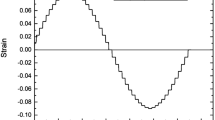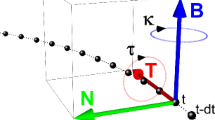Abstract
Rheological material functions are used to form our conceptual understanding of a material response. For a nonlinear rheological response, the possible deformation protocols and material measures span a high-dimensional space. Here, we use asymptotic expansions to outline low-dimensional measures for describing leading-order nonlinear responses in large amplitude oscillatory shear (LAOS). This amplitude-intrinsic regime is sometimes called medium amplitude oscillatory shear (MAOS). These intrinsic nonlinear material functions are only a function of oscillatory frequency, and not amplitude. Such measures have been suggested in the past, but here, we clarify what measures exist and give physically meaningful interpretations. Both shear strain control (LAOStrain) and shear stress control (LAOStress) protocols are considered, and nomenclature is introduced to encode the physical interpretations. We report the first experimental measurement of all four intrinsic shear nonlinearities of LAOStrain. For the polymeric hydrogel (polyvinyl alcohol - Borax) we observe typical integer power function asymptotics. The magnitudes and signs of the intrinsic nonlinear fingerprints are used to conceptually model the mechanical response and to infer molecular and microscale features of the material.











Similar content being viewed by others
References
Abramowitz M, Stegun IA (1964) Handbook of mathematical functions with formulas, graphs and mathematical tables. Dover, New York
Bird RB, Armstrong RC, Hassager O (1987) Dynamics of polymeric liquids. Volume 1: Fluid mechanics, 2nd edn. Wiley, New York
Cho KS, Ahn KH, Lee SJ (2005) A geometrical interpretation of large amplitude oscillatory shear response. J Rheol 49(3):747–758
Davis WM, Macosko CW (1978) Nonlinear dynamic mechanical moduli for polycarbonate and PMMA. J Rheol 22(1):53–71
Davis VA, Ericson LM, Parra-Vasquez ANG, Fan H, Wang Y, Prieto V, Longoria JA, Ramesh S, Saini R, Kittrell C, Billups WE, Adams WW, Hauge RH, Smalley RE, Pasquali M (2004) Phase behavior and rheology of SWNTs in superacids. Macromolecules 37(1):154–160
Dealy JM (1995) Official nomenclature for material functions describing the response of a viscoelastic fluid to various shearing and extensional deformations. J Rheol 39(1):253–265
Dealy JM, Wissbrun KF (1990) Melt Rheology and its role in plastics processing: theory and applications. Van Nostrand Reinhold, New York
Dimitriou CJ, Ewoldt RH, McKinley GH (2013) Describing and prescribing the constitutive response of yield stress fluids using large amplitude oscillatory stress (LAOStress). J Rheol 57(1):27–70
Einstein A (1906) Eine neue Bestimmung der Moleküldimensionen. Ann Phys 19: 289
Einstein A (1911) Berichtigung zu meiner Arbeit: Eine neue Bestimmung der Moleküldimensionen. Ann Phys 34: 591
Ewoldt RH (2013) Defining nonlinear rheological material functions for oscillatory shear. J Rheol 57(1):177–195
Ewoldt RH, Hosoi AE, McKinley GH (2008) New measures for characterizing nonlinear viscoelasticity in large amplitude oscillatory shear. J Rheol 52(6):1427–1458
Ewoldt RH, Gurnon AK, López-Barrón C, McKinley GH, Swan J, Wagner NJ (2012) LAOS rheology day, Friday the 13th, Colburn Laboratory, University of Delaware. Rheol Bull 81(2):12–18
Fan X, Bird RB (1984) A kinetic theory for polymer melts. VI. Calculation of additional material functions. J Non Newtonian Fluid Mech 15(3):341–373
Ferry JD (1980) Viscoelastic properties of polymers, 3rd edn. Wiley, New York
Giacomin AJ, Bird RB, Johnson LM, Mix AW (2011) Large-amplitude oscillatory shear flow from the corotational Maxwell model, vol 166, pp 1081–1099
Gurnon AK, Wagner NJ (2012) Large amplitude oscillatory shear (LAOS) measurements to obtain constitutive equation model parameters: Giesekus model of banding and nonbanding wormlike micelles. J Rheol 56(2):333–351
Hair DW, Amis EJ (1989) Intrinsic dynamic viscoelasticity of polystyrene in \(\theta \) and good solvents. Macromolecules 22(12):4528–4536
Hyun K, Wilhelm M (2009) Establishing a new mechanical nonlinear coefficient Q from FT-rheology: first investigation of entangled linear and comb polymer model systems. Macromolecules 42(1):411–422
Hyun K, Kim SH, Ahn KH, Lee SJ (2002) Large amplitude oscillatory shear as a way to classify the complex fluids. J Non-Newton Fluid Mech 107(1–3):51–65
Hyun K, Ahn KH, Lee SJ, Sugimoto M, Koyama K (2006) Degree of branching of polypropylene measured from Fourier-transform rheology. Rheol Acta 46(1):123–129
Hyun K, Baik ES, Ahn KH, Lee SJ, Sugimoto M, Koyama K (2007) Fourier-transform rheology under medium amplitude oscillatory shear for linear and branched polymer melts. J Rheol 51(6):1319
Hyun K, Wilhelm M, Klein CO, Cho KS, Nam JG, Ahn KH, Lee SJ, Ewoldt RH, McKinley GH (2011) A review of nonlinear oscillatory shear tests: analysis and application of large amplitude oscillatory shear (LAOS). Prog Polym Sci 36(12):1697–1753
Johnson RM, Schrag JL, Ferry JD (1970) Infinite-dilution viscoelastic properties of polystyrene in \(\theta \)-solvents and good solvents. Polymer Japanese 1(6):742–749
Keita G, Ricard A, Audebert R, Pezron E, Leibler L (1995) The poly(vinyl alcohol) borate system—influence of polyelectrolyte effects on phase-diagrams. Polymer 36(1):49–54
Kirkwood JG, Plock RJ (1956) Non-Newtonian viscoelastic properties of rod-like macromolecules in solution. J Chem Phys 24(4):665–669
Koike A, Nemoto N, Inoue T, Osaki K (1995) Dynamic light-scattering and dynamic viscoelasticity of poly(vinyl alcohol) in aqueous borax solutions. 1. Concentration effect. Macromolecules 28(7):2339–2344
Kurokawa H, Shibayama M, Ishimaru T, Nomura S, Wu WI (1992) Phase-behavior and sol–gel transition of poly(vinyl alcohol) borate complex in aqueous-solution. Polymer 33(10):2182–2188
Lin HL, Liu YF, Yu TL, Liu WH, Rwei SP (2005) Light scattering and viscoelasticity study of poly(vinyl alcohol)-borax aqueous solutions and gels. Polymer 46(15):5541–5549
Macosko CW (1994) Rheology: principles, measurements and applications. Wiley, New York
Onogi S, Masuda T, Matsumoto T (1970) Non-linear behavior of viscoelastic materials. I. Disperse systems of polystyrene solution and carbon black. J Rheol 14(2):275–294
Osaki K (1973) Viscoelastic properties of dilute polymer solutions. Advan Polym Sci 12: 1–64
Osaki K, Mitsuda Y, Johnson RM, Schrag JL, Ferry JD (1972) Infinite-dilution viscoelastic properties. Macromolecules 5(1):17–19
Paul E (1969) Non-Newtonian viscoelastic properties of rodlike molecules in solution: comment on a paper by Kirkwood and Plock. J Chem Phys 51(3):1271–1272
Pearson DS, Rochefort WE (1982) Behavior of concentrated polystyrene solutions in large-amplitude oscillating shear fields. J Poly Sci: Poly Phys Edit 20(1):83–98
Pipkin AC (1972) Lectures on viscoelasticity theory. Springer, New York
Ravindranath S, Wang S-Q, Olechnowicz M, Chavan VS, Quirk RP (2010) How polymeric solvents control shear inhomogeneity in large deformations of entangled polymer mixtures. Rheol Acta 50(2):97–105
Reinheimer K, Grosso M, Hetzel F, Kübel J, Wilhelm M (2012) Fourier transform rheology as an innovative morphological characterization technique for the emulsion volume average radius and its distribution. J Colloid Interface Sci 380(1):201–212
Rogers SA (2012) A sequence of physical processes determined and quantified in, LAOS: an instantaneous local 2D/3D approach. J Rheol 56(5):1129
Rogers SA, Lettinga MP (2012) A sequence of physical processes determined and quantified in large-amplitude oscillatory shear (LAOS):application to theoretical nonlinear models. J Rheol 56(1):1–25
Tuteja A, Mackay ME, Hawker CJ, Van Horn B (2005) Effect of ideal, organic nanoparticles on the flow properties of linear polymers: Non-Einstein-like behavior. Macromolecules 38(19):8000–8011
Vrentas JS, Venerus DC, Vrentas CM (1991) Finite-amplitude oscillations of viscoelastic fluids. J Non-Newtonian Fluid Mech 40(1):1–24
Wagner MH, Rolon-Garrido VH, Hyun K, Wilhelm M (2011) Analysis of medium amplitude oscillatory shear data of entangled linear and model comb polymers. J Rheol 55(3):495–516
Wang S, Ravindranath S, Boukany PE (2011) Homogeneous shear, wall slip, and shear banding of entangled polymeric liquids in simple shear rheometry: a roadmap of nonlinear rheology. Macromolecules 44(2):183–190
Wilhelm M (2002) Fourier-transform rheology. Macromol Mater Eng 287(2):83–105
Acknowledgements
The authors are grateful to Prof. Jozef Kokini and Dr. Francesca Devito of the University of Illinois at Urbana-Champaign for use of the ARES-G2 rheometer.
Author information
Authors and Affiliations
Corresponding author
Additional information
Special issue devoted to novel trends in rheology.
Appendix: Constitutive models used
Appendix: Constitutive models used
Corotational Maxwell model
The specific choice of this constitutive model is motivated by the simplicity in its definition and the existence of analytical solutions for the higher harmonics in the shear stress response under LAOS (Giacomin et al. 2011). Another unique feature of this model is that the shear stress is naturally nonlinear, due to the corotational derivative. The two-constant corotational Maxwell model is defined as follows:
where the high-frequency plateau modulus is \({G=\eta _0} /\lambda \) and the time derivative
is the Jaumann derivative defined through the material derivative \(D\underline {\underline \sigma } /{Dt=\partial \underline {\underline \sigma }} / {\partial t}+\left ({\underline {\textrm v} \cdot \underline {\nabla } }\right )\underline {\underline \sigma } \), and
is the rate of strain tensor and
is the vorticity tensor. For an oscillatory shear flow of the form
Giacomin et al. (2011) represent the shear stress response as a power series expansion in the higher powers of strain-rate amplitude
and obtain analytical expressions for the shear stress (their Eq. 58) and the viscosity coefficients \(\eta _{jn}^{\prime } ( \omega )\) and \(\eta _{jn}^{\prime \prime } ( \omega )\) up to the fifth harmonic (their Eqs. 160–171). Their shear stress expansion includes Weissenberg number \(\left ( {\text {Wi}=\dot {\gamma }_0 \lambda =\gamma _0\text {De}} \right )\) as front factors at various order (Wi\(^{2}\) and Wi\(^{4})\). This can be equivalently interpreted as an expansion with respect to strain-rate amplitude \(\dot {\gamma }_0 \) or strain amplitude \(\gamma _{0}\). Rheological material functions are defined with respect to these experimental variables, rather than dimensionless variables that require a priori knowledge of the material (here, the relaxation time \(\lambda \)). Those authors choose the strain-rate expansion, e.g., as given in their Eqs. 160–171, which results in expressions that depend on both De and \(\lambda \) (the timescale \(\lambda \) remains in the front factors).
We choose the strain amplitude expansion, leaving De \(=\) \(\lambda \omega \) in the front factors, which gives material functions that are only a function of De. This is a simpler representation, which we prefer. This is found most directly from the dynamic viscosity coefficients (their Eqs. 160–171). We convert these viscosity coefficients to our notation and define the normalized intrinsic nonlinearities as a function of De,
The above measures are normalized by the plateau modulus G and steady shear viscosity \(\eta _{0 } = G\lambda \) which follow from the Maxwell-type linear viscoelastic response. It can be seen from Eqs. 47–50 that these intrinsic nonlinearities do not depend on any nonlinear parameter and are only a function of the Deborah number De. Equations 47–50 are used in Fig. 2.
Giesekus model
The single-mode Giesekus model is defined by a tensor equation in polymeric stress \(\underline {\underline \sigma } \) as (Bird et al. 1987)
where
is the upper convected time derivative, \(\lambda \) the characteristic relaxation time, and G the plateau modulus. \(\alpha \) is a dimensionless nonlinear parameter, also called the mobility factor, varying between 0 and 1. For a sinusoidal simple shear input \(\gamma ( t )=\gamma _0 \sin \omega t\), Gurnon and Wagner (2012) represent the alternance state polymeric shear stress response as an asymptotic expansion in frequency (index \(n)\) and strain (index \(j)\)
where \(A_n^{( j )} \left ( {\omega ,\gamma _0} \right )\) and \(B_n^{( j )} \left ( {\omega ,\gamma _0} \right )\) are coefficients for the in-phase and out-of-phase components of stress to the deformation input. Expanding Eq. 53 up to the third harmonic and third power of strain, they obtain analytical expressions for the coefficients as a function of the Weissenberg number and Deborah number. We take their asymptotic expressions and convert them to our notations, normalizing them with the linear viscoelastic plateau modulus G and steady shear viscosity \(\eta \)to obtain intrinsic material functions that only depend on De and \(\alpha \),
Rights and permissions
About this article
Cite this article
Ewoldt, R.H., Bharadwaj, N.A. Low-dimensional intrinsic material functions for nonlinear viscoelasticity. Rheol Acta 52, 201–219 (2013). https://doi.org/10.1007/s00397-013-0686-6
Received:
Revised:
Accepted:
Published:
Issue Date:
DOI: https://doi.org/10.1007/s00397-013-0686-6




